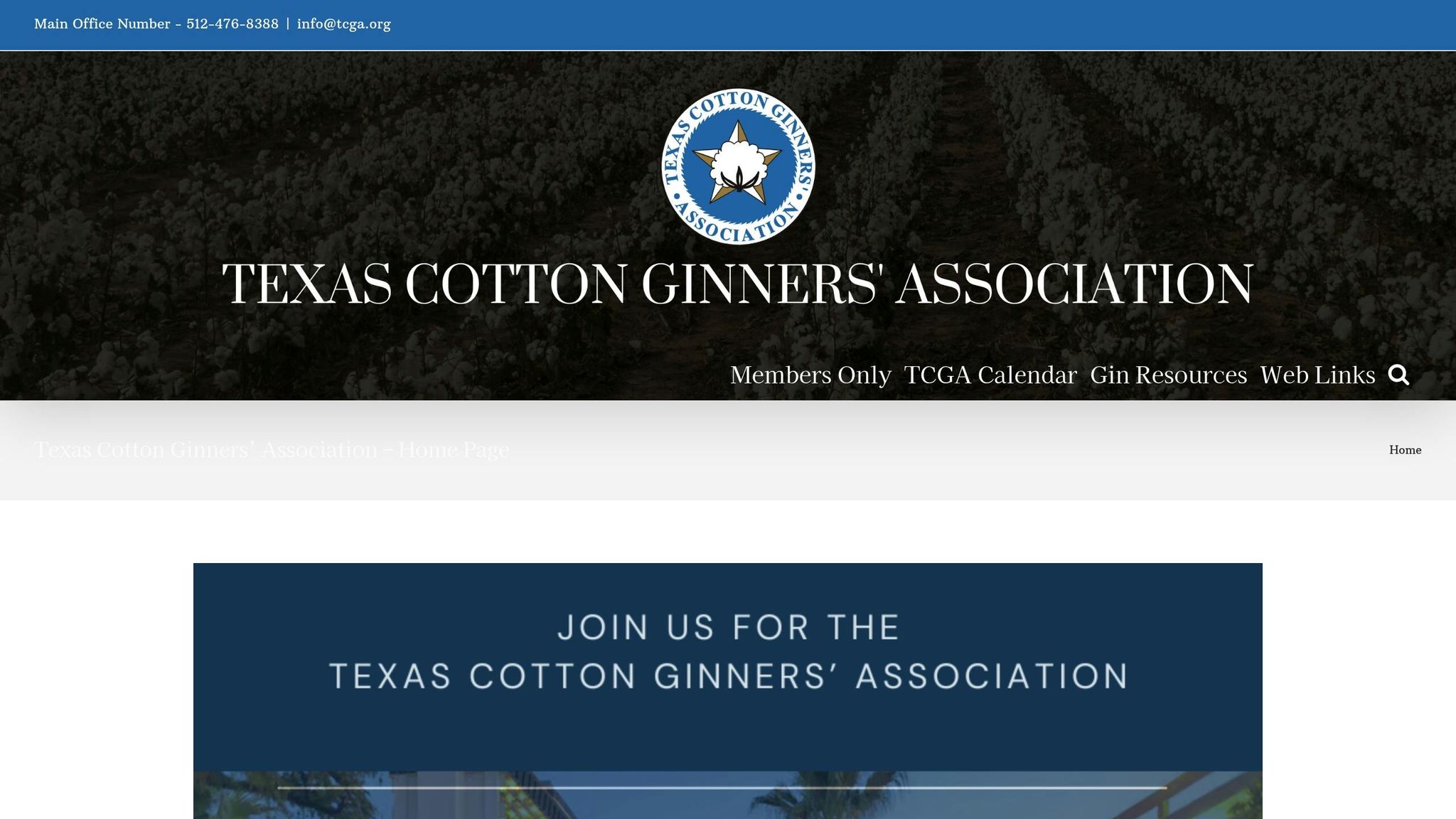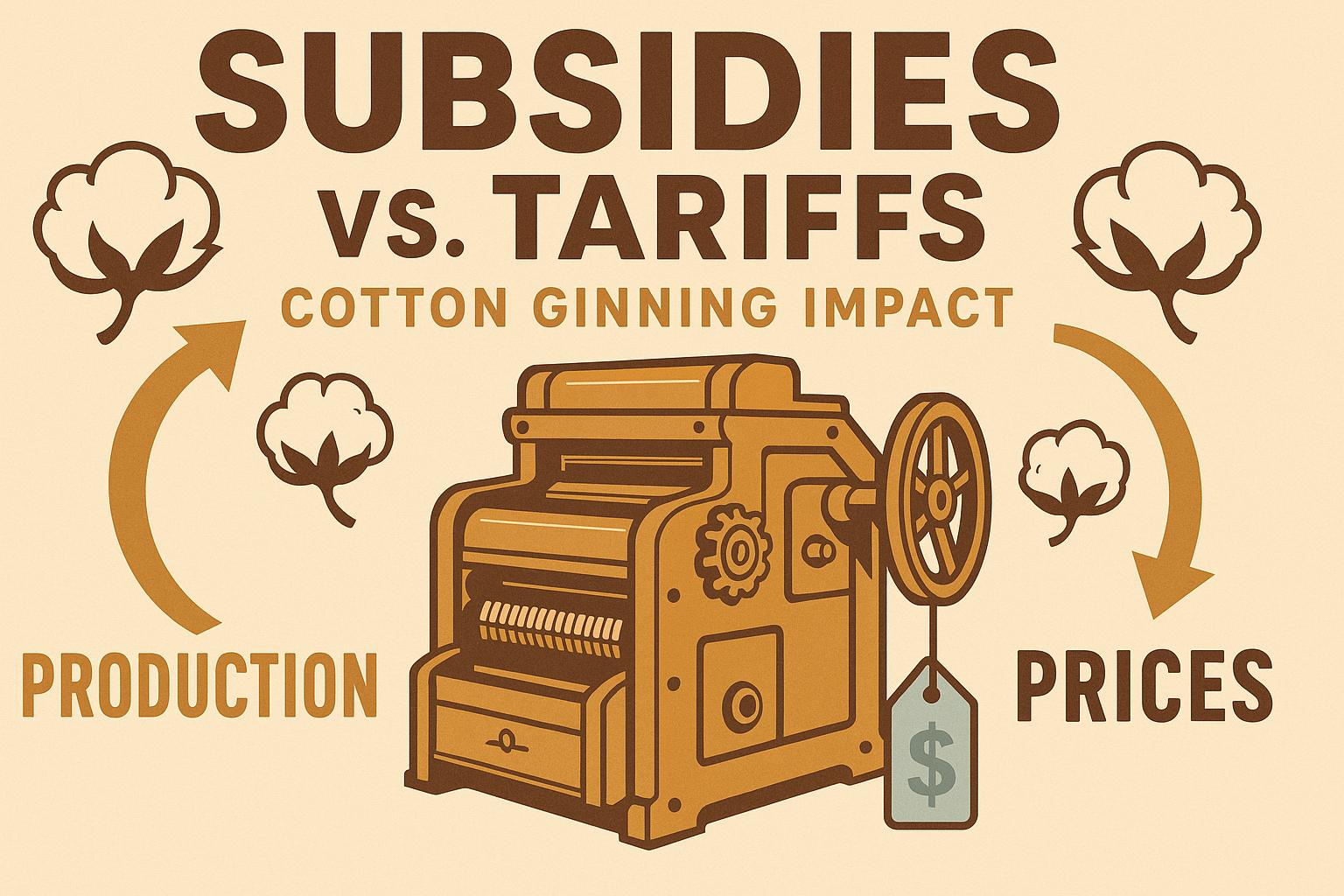Labor costs in cotton ginning have surged, with total variable costs rising 106% from 2019 to 2022. Here's what you need to know:
- Regional Differences: Labor costs per bale vary widely:
- West: $16.80 (highest due to stricter regulations)
- Southeast: $11.09 (lowest due to lower living costs)
- Operation Size Matters: Larger facilities processing over 40,000 bales annually cut costs to $18.39 per bale, while smaller facilities face $24.83 per bale.
- Seasonal Challenges: Hiring seasonal workers for peak demand often requires higher wages and bonuses.
- Automation Impact: Advanced machinery reduces manual labor needs, shifting the focus to skilled technical roles.
Quick Comparison
| Factor | Large Operations | Small Operations |
|---|---|---|
| Labor Cost per Bale | $18.39 | $24.83 |
| Efficiency | Higher (economies of scale) | Lower (fixed costs spread) |
| Seasonal Flexibility | More resources for bonuses | Higher recruitment costs |
To manage rising costs, operators should focus on automation, scaling up, and retaining skilled staff through competitive wages and benefits.
Big Country cotton gins face closure due to shrinking profits, labor shortages, weather

1. Base Pay and Seasonal Work Agreements
The pay structure in cotton ginning operations is closely tied to seasonal demands and regional wage differences. Beyond basic wages, labor costs also include expenses like fringe benefits, Workers' Compensation Insurance, Social Security contributions, and bonuses.
Regional labor costs vary significantly:
| Region | Labor Cost per Bale | Key Factors |
|---|---|---|
| West | $16.80 | Higher minimum wages, stricter regulations |
| Southwest | $11.28 | Competitive local markets |
| Mid-South | $11.51 | Moderate wage requirements |
| Southeast | $11.09 | Lower cost of living |
These regional differences directly impact how seasonal employment agreements are structured. With total variable costs rising by 106% between 2019 and 2022, seasonal agreements have become a crucial tool for managing peak demand periods.
By 2021, the average processing capacity per gin hit a record 53,134 bales, underscoring the importance of flexible staffing strategies. Larger operations benefit from economies of scale, processing higher volumes more efficiently. In contrast, smaller facilities often face higher labor costs per bale, as industry analyses have pointed out.
To address these challenges, operators rely on several strategies:
- Peak Season Wages: Offering higher pay rates to attract temporary workers during harvest.
- Performance Bonuses: Incentive programs designed to boost processing efficiency.
- Benefits Packages: Providing essentials like Workers' Compensation and Social Security coverage.
These structured labor agreements help operators manage costs effectively, with labor expenses accounting for anywhere from 11% to 27% of total variable costs, depending on the year and region.
2. Employee Benefits and Staff Retention
When it comes to keeping a stable workforce, offering competitive wages is only part of the equation - benefits play a huge role too. In today’s tight labor market, where costs are climbing and competition is fierce, a strong benefits package can make all the difference. Since labor expenses take up a large chunk of variable costs, tailoring benefits to meet employee needs is a smart move.
Regional differences often dictate what benefits are offered. For example, operations in the West, where living costs are higher, might provide more comprehensive packages, including health insurance, retirement contributions, and extra perks. Meanwhile, facilities in areas with lower living costs may offer more streamlined benefits. These regional approaches directly impact how well companies can retain employees and manage recruitment costs.
Take, for instance, a gin facility in the Mid-South. By upgrading its benefits - adding health insurance and a seasonal bonus program - it saw its seasonal staff return rate jump from 60% to over 85% in just two years. This not only cut down on recruitment and training costs but also ensured smoother operations during the busiest times of the year.
Health insurance tends to be the cornerstone of a competitive benefits package. Larger operations, especially those handling higher volumes, often have the advantage of economies of scale. This allows them to offer better coverage at a lower cost per bale, which helps with both staff retention and overall efficiency.
Here are some key factors that influence how effective benefits programs can be:
- Seasonal Needs: Offering prorated benefits or bonuses can significantly improve seasonal worker retention.
- Regional Competition: Adjusting benefits to align with local labor market conditions is critical.
- Operational Size: Larger gins have more flexibility to spread out costs and deliver more comprehensive benefits.
Another trend tied to larger operations is the ability to offer year-round employment for key staff. This not only boosts workforce stability but also ensures experienced personnel are available when needed most.
In addition to seasonal wage increases, performance-based incentives have proven to be a strong motivator. These incentives are especially effective in regions like the Southeast, where base wages average $11.09 per bale. Aligning pay with productivity helps keep costs manageable while rewarding hard work.
While enhancing benefits might seem costly upfront, the long-term payoff is clear. Lower turnover and higher efficiency during peak ginning seasons make it a worthwhile investment.
3. Machine Use and Labor Costs
Automation has brought significant changes to cotton ginning, reshaping workforce requirements and cutting labor expenses. By streamlining operations, automation reduces the need for manual labor, which in turn lowers labor costs per bale. For instance, large-scale gins processing over 40,000 bales annually typically see labor costs of about $18.39 per bale, while smaller operations handling fewer than 10,000 bales face higher costs at approximately $24.83 per bale. This evolution is shifting the workforce toward more technical roles, as highlighted below.
Modern ginning equipment has led to a reliance on smaller, more specialized teams instead of large crews handling manual tasks. This change is especially noticeable in maintenance and technical positions. In 2021, the average processing capacity per gin hit 53,134 bales, showcasing how advanced machinery not only increases throughput but also optimizes labor costs.
However, the 2021 and 2022 cotton crops saw unusually high variable costs, with labor and repair expenses taking the lead.
The type of machinery used also plays a big role in operating costs. For example, conventional roller gins come with operating costs that are 24.42% higher than those of saw gins, while high-speed roller gins increase costs by 14.18%.
Key Considerations for Cost Efficiency
To better manage expenses, gin operators need to balance several critical factors:
Initial Investment vs. Long-term Savings
- Automated systems often require a higher upfront cost.
- Over time, they help cut labor expenses significantly.
- They offer more consistent processing results.
- Automation reduces reliance on seasonal labor, minimizing shortages.
Shifting Workforce Dynamics
- There’s a growing need for skilled machine operators instead of general laborers.
- Technical roles and ongoing training are becoming more important.
- These changes create more stable, year-round job opportunities.
While modern machinery demands a substantial initial investment, the long-term benefits - like improved efficiency and reduced labor costs per bale - make it a worthwhile expense. Regular maintenance is essential to keep these systems running smoothly and avoid costly downtime.
sbb-itb-0e617ca
Benefits and Drawbacks
Building on the detailed breakdown of labor cost components, this section dives into the trade-offs cotton gin operators face when choosing between staffing strategies, automation, and other cost-management approaches.
Seasonal vs. Year-Round Staffing
| Aspect | Seasonal Staffing | Year-Round Employment |
|---|---|---|
| Cost Flexibility | Adapts easily to production demands | Fixed annual expenses |
| Worker Expertise | Limited institutional knowledge | Retains skilled workers |
| Training Investment | Requires annual retraining | One-time initial investment |
| Operational Stability | Performance varies seasonally | Consistent quality year-round |
| Wage Requirements | Higher hourly rates | Predictable costs |
Seasonal staffing offers flexibility in managing costs during peak production but can lead to inconsistent performance and higher retraining needs. On the other hand, year-round employment ensures stability and retains expertise, though it comes with fixed labor expenses. These differences highlight the need to balance cost savings with operational reliability.
Regional Cost Variations
Regional labor cost disparities often push operators in high-cost areas to prioritize automation. In such regions, where wages significantly impact budgets, facilities tend to adopt strategies that control expenses while maintaining productivity.
Scale Economics and Labor Efficiency
The size of operations directly affects labor efficiency, as shown below:
| Processing Volume (bales) | Labor Cost per Bale | Efficiency Gain |
|---|---|---|
| Less than 10,000 | $24.83 | Baseline |
| 15,000 – 25,000 | $19.89 | 19.9% savings |
| More than 40,000 | $18.39 | 25.9% savings |
Larger facilities enjoy lower labor costs per bale due to economies of scale, making high-volume processing a more efficient option. Smaller operations, by contrast, face higher per-unit costs, limiting their competitiveness.
Automation vs. Traditional Labor
Investing in automation comes with steep upfront costs, but the long-term savings can be substantial. By reducing reliance on manual labor, automation helps operators lower ongoing expenses. However, balancing the cost of technology with traditional labor models is critical, especially when evaluating the added value of employee benefits.
Employee Benefits Impact
Offering strong employee benefits might increase short-term costs, but it can lead to lower turnover and greater workforce stability. This approach reduces retraining expenses and ensures consistent quality, creating a positive cycle of efficiency and retention. For operators, the challenge lies in weighing these upfront costs against the long-term advantages of a stable and skilled workforce.
Conclusion
The rise in labor costs for cotton ginning demands well-thought-out, data-backed strategies. Industry data reveals a staggering 106% increase in variable costs per bale, now reaching $49.31. This sharp rise underscores the pressing need for smarter cost management.
Regional differences play a big role in labor expenses. For instance, gins in the Western U.S. face the highest labor costs at $16.80 per bale, while those in the Southeast benefit from lower rates at $11.09 per bale. These disparities make it clear that cost-saving strategies need to be tailored to specific locations.
Economies of scale also stand out as a key factor in managing labor costs. Larger facilities processing over 40,000 bales annually see costs drop to $18.39 per bale, while smaller operations handling fewer than 10,000 bales face much higher costs at $24.83 per bale. This 25.9% gap demonstrates the financial advantages of increasing processing capacity.
To address these challenges, operators can focus on several targeted strategies:
| Strategy | Key Focus |
|---|---|
| Volume Optimization | Boost processing capacity to benefit from economies of scale |
| Regional Adaptation | Adjust operations to reflect local labor cost differences |
| Technology Investment | Implement automation and modern equipment to improve efficiency |
| Workforce Development | Strengthen training and retention programs to lower turnover and costs |
By prioritizing these areas - processing volume, regional adjustments, automation, and workforce training - operators can better navigate rising labor costs.
The 2021 average processing capacity has set a new benchmark for efficiency. This shift toward larger, more modernized operations signals that consolidation and technological upgrades will likely remain key drivers in managing labor costs across the industry.
FAQs
How do regional labor cost differences affect the efficiency and competitiveness of cotton ginning operations?
Regional Impact on Labor Costs in Cotton Ginning
Labor costs can vary dramatically from one region to another, and these differences can have a big impact on how efficiently and competitively cotton ginning operations run. Key factors like local wage rates, the availability of skilled workers, and additional expenses such as health insurance or overtime pay all contribute to the overall labor budget.
In regions where labor costs are higher, ginning operations often face tighter profit margins. This can push companies to explore options like increasing automation or finding ways to streamline their processes to stay competitive. On the flip side, areas with lower labor costs may enjoy a financial edge, but they’re not without challenges. Seasonal labor shortages, for example, can still disrupt operations.
Effectively navigating these regional differences is crucial for staying ahead in the cotton ginning industry. It requires a careful balance of managing costs while addressing workforce availability and operational needs.
What are the long-term advantages and potential challenges of automating cotton ginning facilities?
The Pros and Cons of Automation in Cotton Ginning Facilities
Investing in automation for cotton ginning facilities brings a range of long-term benefits. For starters, it can cut labor costs by automating tasks that typically depend on manual effort. This not only saves money but also boosts efficiency and consistency, which can result in higher productivity and better-quality cotton. On top of that, automated systems often come with built-in tracking and monitoring capabilities, making it easier to plan maintenance and make informed decisions.
That said, there are some challenges to keep in mind. The upfront costs of automation equipment can be steep, requiring significant financial commitment. Facilities may also need to invest in training their staff to properly operate and maintain these advanced systems. Another concern is technological obsolescence - as automation technology evolves, keeping systems up-to-date might demand periodic upgrades. Taking the time to weigh these pros and cons can help determine if automation is the right fit for a facility's needs.
What strategies can smaller cotton ginning businesses use to manage rising labor costs while staying competitive?
Smaller cotton ginning businesses can tackle the challenge of rising labor costs by focusing on smarter operations and thoughtful planning. One effective strategy is to invest in automation and modern equipment, which reduces the need for manual labor while boosting productivity. This not only cuts costs but also helps streamline day-to-day operations.
Another way to manage expenses is by adjusting staffing levels based on seasonal demand. During peak times, having enough workers ensures smooth operations, while scaling back during slower periods helps keep costs in check.
To attract and keep skilled workers, offering competitive pay and benefits is crucial. However, these costs can be balanced by improving efficiency and cutting down on waste. Regular training sessions can also play a big role in increasing employee productivity and morale, creating a win-win for both workers and the business. With these strategies, smaller ginning operations can stay competitive even as labor costs rise.


